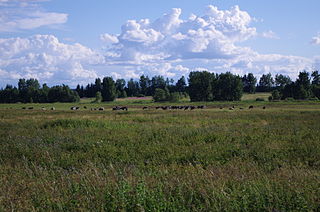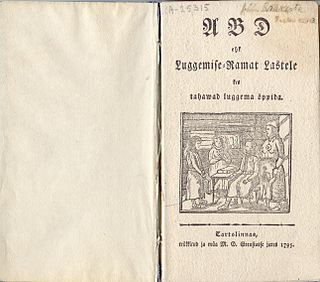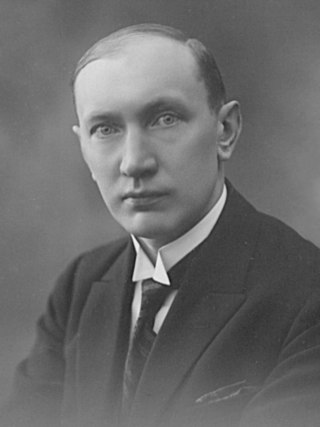
Tartu is the second largest city in Estonia after Tallinn. Tartu has a population of 97,435. It is 186 kilometres southeast of Tallinn and 245 kilometres northeast of Riga, Latvia. Tartu lies on the Emajõgi river, which connects the two largest lakes in Estonia, Lake Võrtsjärv and Lake Peipus. From the 13th century until the end of the 19th century, Tartu was known in most of the world by variants of its historical name Dorpat.

The University of Tartu is a public research university located in the city of Tartu, Estonia. It is the national university of Estonia. It is also the largest and oldest university in the country. The university was founded under the name of Academia Gustaviana in 1632 by Baron Johan Skytte, the Governor-General of Swedish Livonia, Ingria, and Karelia, with the required ratification provided by King Gustavus Adolphus, shortly before the king's death on 6 November in the Battle of Lützen (1632).

Tartu County is one of 15 counties of Estonia.

Established in 1918, Tallinn University of Technology is the only technical university in Estonia. TalTech, in the capital city of Tallinn, is a university for engineering, business, public administration and maritime affairs. TalTech has colleges in Tartu and Kohtla-Järve. Despite the similar names, Tallinn University and Tallinn University of Technology are separate institutions.

Andres Tarand is an Estonian geographer, climatologist and politician who served as the Prime Minister of Estonia from 1994 to 1995. He was also a Member of the European Parliament (MEP) for the Social Democratic Party, part of the Party of European Socialists, between 2004 and 2009.

The Governorate of Livonia, also known as the Livonia Governorate, was a province (guberniya) and one of the Baltic governorates of the Russian Empire, Baltic Governorate-General until 1876. Governorate of Livonia bordered Governorate of Estonia to the north, Saint Petersburg and Pskov Governorates to the east, Courland Governorate to the south, and the Gulf of Riga to the west. In 1897, the population of the governorate was 1,299,365, and it had an area of 47,030.87 square kilometres (18,158.72 sq mi). The administrative centre of the governorate was the Baltic Sea port of Riga. It roughly corresponded to most of the modern Vidzeme Region of Latvia and southern Estonia.
The Estonian University of Life Sciences is a public university located in Tartu, Estonia. Its roots trace back to 1802, when the Chair of Agriculture was founded in the University of Tartu. EMÜ is the 4th largest public university in Estonia.
Tõnis Kint was an Estonian politician. He served as "Prime Minister in duties of the President" from 23 December 1970 to 1 March 1990.

Jaak Aaviksoo is an Estonian politician and physicist, a former rector of the University of Tartu and Tallinn University of Technology (TalTech).

The history of formal education in Estonia dates back to the 13–14th centuries when the first monastic and cathedral schools were founded. The first primer in the Estonian language was published in 1575. The oldest university is the University of Tartu which was established during the reign of King Gustav II Adolf of Sweden in 1632. The beginnings of the Estonian public education system appeared in the 1680s, largely due to efforts of Bengt Forselius, who also introduced orthographical reforms to written Estonian.
The Estonian Small Cup is a knock-out competition for Estonian amateur teams, which play in the 4th or lower level. The first competition was won by Kohtla-Järve JK Alko in 2005 and the latest title was given to Saue JK. Finals are held in Tallinn, A. Le Coq Arena since 2007.

Paul Nikolai Kogerman was an Estonian chemist and founder of modern research in oil shale.

Tartu Cathedral, earlier also known as Dorpat Cathedral, is a former Catholic church in Tartu (Dorpat), Estonia. The building is now an imposing ruin overlooking the lower town. About a third of the cathedral has been renovated. In the part of it that has been renovated is now located the museum of the University of Tartu, which the university also uses for major receptions.
Valve Pormeisternée Ulm was an Estonian landscape architect who became an architect. She was one of the first women to influence the development of Estonian architecture, becoming one of the country's most inventive modernisers of rural architecture in the 1960s and 1970s. She is often known as the "Grand Old Lady" of Estonian architecture.

Von Bock House is in Ülikooli Street in Tartu in Estonia. The building is owned by Tartu University, and is on the same street as the university's main building. Von Bock house has a mural of the university's main building on one of its walls.

University of Tartu Folk Art Ensemble is a University of Tartu folk dance group. It was founded in 1945 and as of 2015 there were around 150 dancers, that makes it one of the oldest and biggest folk dance groups in Estonia.
August Johannes Salum was an Estonian veterinarian and politician. He was a member of IV and V Riigikogu. He was a member of the Riigikogu beginning on 2 September 1930, when he replaced Hans Miller.
Elmar Roots was an Estonian veterinarian.

Ülle Jaakma is an Estonian agronomist. Since on 1 January 2023, she is the rector of Estonian University of Life Sciences.













